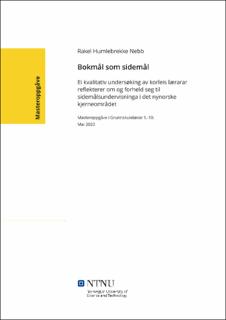| dc.contributor.advisor | Reite, Andre Midtskogseter | |
| dc.contributor.advisor | Riksem, Brita Ramsevik | |
| dc.contributor.author | Nebb, Rakel Humlebrekke | |
| dc.date.accessioned | 2022-07-22T17:21:09Z | |
| dc.date.available | 2022-07-22T17:21:09Z | |
| dc.date.issued | 2022 | |
| dc.identifier | no.ntnu:inspera:113334384:26773040 | |
| dc.identifier.uri | https://hdl.handle.net/11250/3007917 | |
| dc.description.abstract | I dag har om lag 12 % av elevane i norsk skule nynorsk som hovudmål og bokmål som sidemål (Statistisk sentralbyrå, 2021), noko som vil seie at det er ganske mange elevar som skal ha sidemålsopplæring i bokmål. Likevel er dette emnet lite undersøkt, og forskinga på dette temaet er minimal.
Med dette som utgangspunkt undersøker denne studien nettopp dette emnet, bokmål som sidemål. Gjennom kvalitative forskingsintervju med fem norsklærarar som arbeider ved skular kor nynorsk er hovudmål, er målet å finne ut noko om korleis desse lærarane tenkjer om og prioriterer i sidemålsopplæringa i skulen. Med bakgrunn i sosiokulturelle perspektiv på språk, som haldningar og ideologiar, og lærarkognisjon (Borg, 2003) og Language Awareness (Svalberg, 2007, s.288), og grammatiske sideblikk på opplæringa, tek denne studien opp spørsmål kring haldningar og gjennomføring av sidemålsopplæring.
Eitt av hovudfunna i denne studien er at måtane desse lærarane snakkar om sidemål på, er sterkt prega av korleis sidemål vert omtala på samfunnsnivå. Lærarane brukar meir tid på å snakke om nynorsk som sidemål, og legitimere det, framfor å faktisk snakke om bokmål som sidemål. Den asymmetriske maktrelasjonen mellom bokmål og nynorsk (Bull, 2004), speglar seg òg att i skular kor nynorsk er majoritetsspråket. Det kjem òg fram at målet med sidemålsopplæringa er eine og aleine å kunne skrive på sidemålet, og ikkje nødvendigvis å ha oversikta over dei to språka. Grammatikkundervisninga er til for å gjere elevane til betre skrivarar, og består difor av tips og triks for korrekt skriving. Fleire av lærarane fortel at elevane skriv godt på sidemålet sitt før dei startar med eksplisitt undervisning, noko som gjer at dei kan utsetje emnet og nedprioritere sidemålsundervisninga. Elevane sine forkunnskapar i bokmål vert grunngjeve i at elevane i stor grad vert eksponerte for sidemålet sitt, og den implisitte læringa av bokmål erstattar dermed den eksplisitte læringa.
Dette leier fram til eitt av mine hovudpoeng i denne studien, som er at ein treng den eksplisitte undervisninga i språkopplæringa, kor ein legg til rette for bevisstheita kring språksystema. På denne måten vil elevane kunne lære å skrive både på sidemålet og hovudmålet sitt. Då vil sidemålsundervisninga vere ein del av den heilskaplege norskopplæringa, og gjere elevane til bevisste og trygge språkbrukarar i begge språk. | |
| dc.description.abstract | Today, about 12 % of pupils in the Norwegian school system learn nynorsk as their first-choice form of Norwegian and bokmål as their second-choice form of Norwegian (Statistisk sentralbyrå, 2021). This means that there are many students who learn bokmål as their second-choice form. Despite that implication, this topic is mostly unexplored, and the research on this topic is minimal.
This study explores the topic of bokmål as a second-choice form of Norwegian in light of the aforementioned context. The goal is to figure out how teachers think about and prioritize second language teaching in school through qualitative interviews with five Norwegian teachers, who all work in areas where nynorsk is the first language. With the theoretical groundwork about sociocultural linguistics, such as attitudes and ideologies, and Teacher cognition (Borg, 2003, s.) and Language Awareness (Svalberg, 2008, s.288), and lastly grammatical perspectives, this study explores the questions around attitudes towards and implementation of the education in the second-choice form of Norwegian.
One of the main findings of the study is that the way teachers speak about the second-choice form of Norwegian is strongly influenced by the way that this topic is spoken about at a societal level. Teachers spend more time talking about nynorsk as this kind of Norwegian for other students, and legitimizing this practice, than talking about bokmål as the second-choice form. The asymmetric power relationship between nynorsk and bokmål (Bull, 2004), is also reflected in the schools where nynorsk is the majority language. It also appears that the goal of teaching the second-choice form is only to learn to write this language, and not necessarily get an overview of the two languages. The main function of grammar teaching is to make the students better writers, and therefore consists of tips and tricks for writing correctly. Several of the teachers say that the students write well in their second-choice form before they start with the explicit teaching of it, which allows the teacher to postpone and minimize the importance this subject. The students’ prior knowledge in bokmål is primarily due to the exposure these students have within bokmål, and the implicit teaching of bokmål then replaces explicit teaching.
This leads to one of my main arguments in this study; that the students need explicit teaching of the groundwork for language systems awareness so that students can write in both their first-choice form and their second-choice form of Norwegian. This way, the second-choice form-teaching will be an integral part of Norwegian education that enables students to become informed and secure language users in both languages. | |
| dc.language | nno | |
| dc.publisher | NTNU | |
| dc.title | Bokmål som sidemål – ei kvalitativ undersøking av korleis lærarar reflekterer om og forheld seg til sidemålsundervisninga i det nynorske kjerneområdet | |
| dc.type | Master thesis | |
